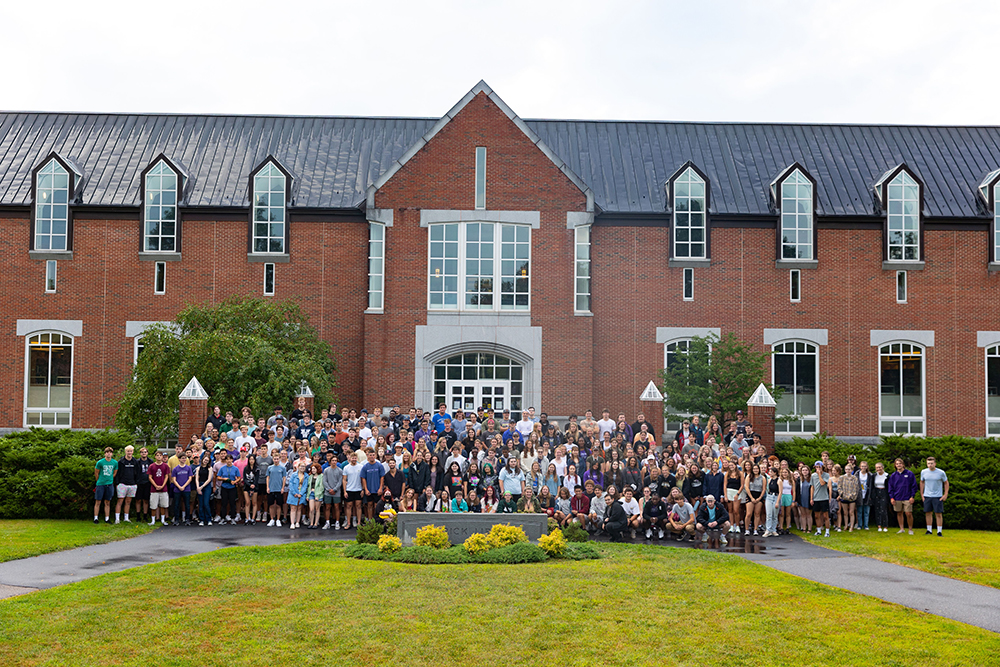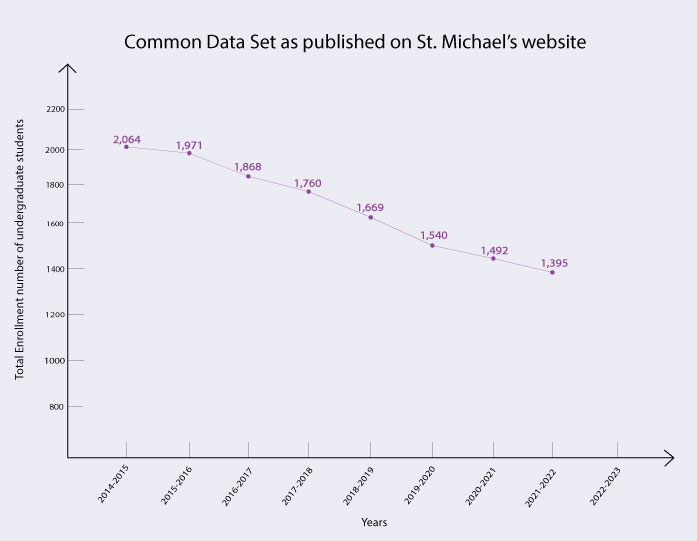Administration responds to the challenge

Dakota Thomas & Minqi Kong | Staff Writers | mkong@mail.smcvt.edu dthomas2@mail.smcvt.edu
Like many small liberal arts colleges, the May 1, 2022, National College Decision Day, proved to be disappointing at St. Michael’s College when the number of first-years students and transfer students totaled 294, well under the 380 anticipated. The smaller incoming class is forcing the college to make difficult decisions. This uncertainty about the financial future of the school naturally causes speculations and rumors to begin to churn among students.
According to data collected by The National Student Clearinghouse Research Center, undergraduate enrollment across the United States has dropped 4.7 percent this spring or over 662,000 students from spring 2021. On top of this decline in students, standardized test scores became optional to submit on the Common Application amidst the pandemic, causing larger state schools and Ivy League applications to sky-rocket while less competitive schools have seen even greater decrease in admissions.

There are a combination of influences that can explain the predicament of smaller institutions. Small colleges rely on the tuition dollars of every student to stay afloat, without having amenities such as athletic revenue, large endowments or research grant funds. The Common Data Set 2019-2020, published on the college’s website, shows that the total full-time, first-years who enrolled in the semester prior to the pandemic’s start, was 392 students. This number is similar to the number of students expected for the class of 2026, with the school budgeting for 380 incoming students.
Colleges have been watching the demographics for years now, anticipating this decline in enrollment due to the lowering birth rate of the United States. The CDC Provisional Data showed the United States birth rate in 2020 was down 4% from the year before. With more students opting for larger public universities, Kristin McAndrew, the Vice President of Enrollment and Marketing Communication, said their team is visiting high schools and incorporating a PR professional as just one part of the plans to promote the school. “We are also listening to what students value and evolving as an institution to respond. New programs, campus improvements—are all part of attracting new students,” McAndrew said.
While some academic majors at the college are growing in student numbers, others are declining. At this point the college has not decided to cut any majors, but Jeffrey Trumbower, vice president of Academic Affairs said they might have to consider cutting majors which have less enrollment in coming months. At the same time, he said, they need to consider new majors. “Developing a major in one sense can be a way to attract new students,” he said. The criminology major grew out of a pre-existing minor that the school had, but fall 2020 was the first crop of new students who came to St. Michael’s specifically because the school had that major. “It has attracted a lot of students to the college,” Trumbower said. Currently the school has 41 students, including five first-year students in the Criminology major. When students apply to college, they first look for what major categories the school has, so opening up new and popular majors is one way to attract more students to visit.
Trumbower emphasized the value of going to a small school. “We have a lot of students who do research with faculty either in the summer or during the school year, that is a real advantage of coming to a small school that you get to work with faculty members on research that may get published and that’s rare in those big universities because it’s all about graduate students, and here it’s undergraduate. So, we are doing some steps to highlight that to make sure that’s better known,” Trumbower said.
These financial strains have not halted important academic changes happening on campus, McAndrew said, mentioning the Media Creation Studio that was just added to St. Edmund’s Hall, the Purposeful Learning program to advise and support new students, as well as a graduate certificate in Racial Equity and Educational Justice which will attract more teachers to further their education at St. Michael’s. With a small population, the school is trying to make the most of its small community, such as its initiative for students to participate in the personable atmosphere that draws students to small liberal arts schools.
The Vice President of Student Affairs, Dawn Ellinwood, made it clear that these financial hardships never restrict the support available for students. “Our students are why we’re here… supporting students…having extracurricular, co-curricular activities, making sure resident halls and living spaces, public safety, food, all of that stuff that supports students’ success in the classroom are really important.” Spending is being looked at with a critical eye and direct student services will continue to be prioritized. Ellinwood also highlighted the new student engagement that is picking up “I think students are so excited to have a normal college experience and not be as concerned because we’re a highly vaccinated campus. I feel the energy on campus is really positive and people are eager.” Engagement on campus is substantial, with the last Friday Knight Dry event bringing in more than 500 students.
The President’s Office commented “The higher education landscape is shifting rapidly—fewer students are going to college and what those students want from their college experience is changing. But while many schools lack the resources that will allow them to adapt to this increasingly competitive environment, Saint Michael’s is fortunate. We have a strong endowment, the support of generous alumni and donors, and we’ve managed our finances well over time. As a result, we have the resources we need to innovate and evolve.”
Robert Robinson, vice president of finance said he works closely with the enrollment division and bases their financial planning on projected enrollment. “One of the school’s sources of revenue is student tuition, and despite having low enrollment, in recognition of the hard work and dedication of all employees across campus, the college is offering a 5.0 percent across-the-board salary increase in May 2022.” According to the information provided by Robinson, the school has maintained the same level of spending and even raised salaries for school staff despite lower enrollment. “We can’t attract students without strong staff and faculty,” Robinson said, “The school has generous donors and prudent financial management, and St. Michael’s has a substantial endowment, which has allowed the school to innovate and grow.” The school is making strategic investments, such as the Center for Global Engagement, which has enhanced the school’s international recruitment efforts, as one of those developments.
Dawn Ellinwood said, “St. Michael’s is not like other institutions I’ve been to, I’ve gone as a student, but also I worked at five other institutions, which were lovely institutions… St. Michael’s does it in a different way. So I’m very optimistic.”

